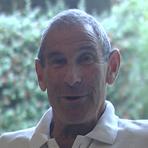
|
The world of non-commercial film and A-V |
Events Diary | Search | ||
| The Film and Video Institute | | ||||
The making of On Silk
|
| Watching an artist painting a picture might be thought similar to watching grass grow. I was therefore somewhat doubtful of the prospects of success when my artist wife suggested that painting on silk might be a good subject for the type of films that I like to make. She had been very exited by the experience of silk painting which she had recently embarked on at our local art institute where a class was being conducted by a well known silk artist. |

|
I had a look at what the students were doing and was impressed by the visual possibilities that the act of applying paint to silk might offer to the film maker, quite apart from the wonderful pictures that resulted. I discussed the matter with the artist and he offered to come to our house on the mornings of the weekly class and do his own work there for me to film, provided I then drove him with all his kit round the corner to the Art Institute. |
This all started in March 2003 and by June the film was pretty well shot. We have a large “garden” room at home with lots of big windows which is ideal for a studio and I could be sure of good light which I supplemented with household lights. I had to be sure of doing a careful “white balance” on the camera and even then I did find that my colour balance did need to be adjusted in post production.
I was fortunate in that I had complete control over the shoot, unlike in some documentaries when, as a one man band, I find myself struggling to get the material I need.
I shoot DV Cam digital tape on a Sony DSR 300 with the Fuji lens. This is a big heavy camera but very versatile and I like the possibilities afforded by the minimal depth of field at the tele end of the lens. The sound quality is good too with proper XL inputs. The only problem is that I need a big heavy tripod to hold it!
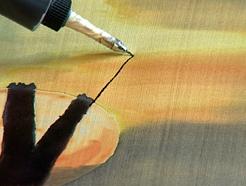
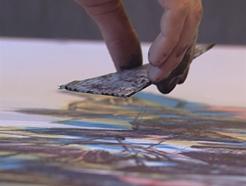
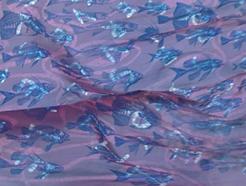
To make the most of the visuals I had to get in really close and try and anticipate the path of the artist’s brush since, although he was doing it for the film, I did not want constantly to interrupt him as he was doing a serious piece of work. The action was slow moving so my being very close in had the effect of making it appear faster besides creating a more dramatic effect.
I don’t know if the readers of this have seen the film but I am assuming that they have. I was agonising over whether to limit the film to the main piece the artist was working on or include other work which gave me more scope for illustrating different techniques used as well as extending the visual aspects of the film. I decided to include the other work but some viewers thought that it distorted the structure of the production.
One of my joys in film making is to use music as an integral part of the work and I took the opportunity of constructing some of my most effective “music to visuals” sequences, using mostly some wonderful harp music and floating painted silk scarves down in front of the camera. I also managed to create some dreamlike sequences with silks floating in a swimming pool. I slowed the action in post production and employed long dissolve mixes which give a nice “dreamy” feel to the sequence.
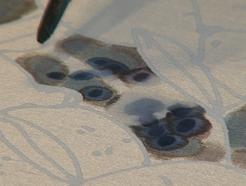
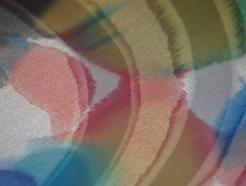
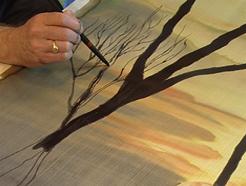
For audio, apart from the music sequences, I used the voice of the artist describing some of his techniques and explaining his artistic aims and thought processes. I showed him some of the material I had shot and sat him down in a quiet place, put two high quality mics close and left him to talk. He does this well at the best of times so I was not short of material to cut and lay as appropriate. Cutting speech is easy on modern editing systems and I could easily construct what I wanted, with of course no fluffs!
Whilst mentioning editing I must pay tribute to my Media 100i which is so similar to the old film editing on which I was brought up, that I was able to make the transition from film to tape so much more easily than I feared. It operates on Macs, is wonderfully versatile, and satisfies the most demanding editors. For multi layering, something I don’t need, there is the 844 version and they are shortly introducing a system like mine that will handle the new High Def video alongside Standard Def. on the same timeline as well as converting 4:3 aspect to 16:9 and vice versa with no loss of quality.
Any film maker will know the sensation of sitting amongst an audience watching his own film for the hundredth time and wishing that this and that had been cut or trimmed and I have now learned to print off draft copies of a final cut and project on a big screen as often as time allows to people whose judgement I respect. That way I not only get feed back but gradually hone the finished product as a result of almost getting bored with it. An audience generally gets only one viewing it is true but faults tend to get highlighted by repeated viewings.
In this film I was able to combine most of the elements that I aim for in a production. Firstly I always seek to make an impact with the visuals and this often determines my choice of subject. Secondly I seek opportunities for combining pictures with music in an imaginative style and not merely using the music as “wallpaper”. Thirdly I try and probe inside the mind of the person I am featuring and have them express their point of view.
I think that I achieved most of these objectives in On Silk even if the overall structure could have been tighter. The film has been very popular with a wide range of audiences so I must have been on the right track.
- Michael Slowe May 2005
Share your passions.

Share your stories.
